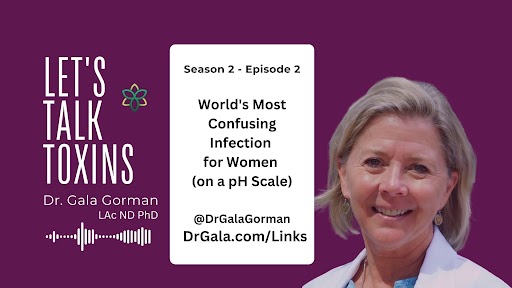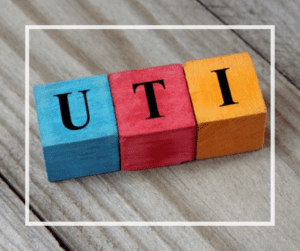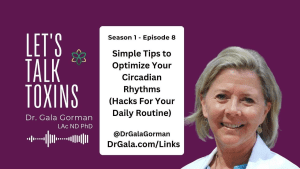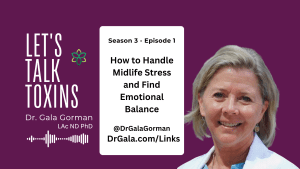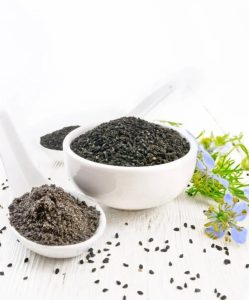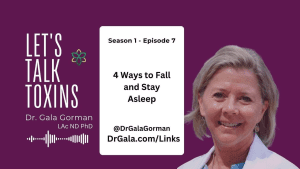NOTE: A machine generated this transcript. Please be aware that it may contain occasional errors in punctuation and spelling.
Recurring bladder infections, that is a sign of disruption in all of that area. And because women’s openings to the outside world allow bacteria to get in to those openings and to have cross-contamination. And so that makes it really important that we practice good hygiene.
Welcome to the Let’s Talk Toxins show. Let’s talk about something that many of us have experienced but few want to discuss. Bacterial vaginosis or vaginal health, essentially. Bacterial vaginosis is sometimes referred to with an acronym BV and that’s what we’ll use as we continue on here today.
But just know that I get you. This is an unwelcome visitor that disrupts things down there causing discomfort and frustration. So, if you’re struggling with BV or any other disturbance with your vaginal health and looking for a natural approach to restore a healthy balance, then you’ll want to stick around for this episode. And make sure you stay to the end where I answer questions from women just like you.
And if you’re new here, I’m Dr. Gala Gorman, a licensed acupuncturist, naturopath, and author of “What’s Your Kryptonite?”. I wrote the book to help women understand the effects of chronic stress that’s turned toxic. In the book, I share the MOLT Method™. I developed to make it easy to shed stress along with the accumulated toxicity just like any other creature in nature that’s outgrown its trappings.
Many women find their way to me after trying everything to deal with their annoying symptoms. You may feel like you’ve learned way more than you ever wanted to know about health and still aren’t healthy… it’s time for a different approach. Symptoms are directly related to stress, but stress isn’t easy to master, and it isn’t going away.
If you’re ready for a new approach that will lead to stress mastery, I highly recommend my MOLT membership. It’s perfect for those who have a strong sense they’re missing something important, that’s the key to optimal wellness. In my membership, we apply the MOLT Method™ I developed. MOLT is an acronym, M for mindset, O for order, L for lifestyle, T for toxins. It’s designed to help you shed stress, cruise through midlife symptom free and end issues like chronic fatigue, insomnia, and even weight gain. Join us and turn your knowledge into real change.
The next segment is what I refer to as toxin trends. So, in this segment, I share information from research studies related to toxicity. And the T in MOLT, as I mentioned a moment ago, stands for Toxins. I can say with confidence that every symptom is caused by accumulated toxicity. I evaluate 12 categories of toxicity when I’m working with someone to unravel a health mystery.
Our world is full of man-made substances that our bodies were not designed to deal with. Coupled this toxicity with an overwhelming amount of toxic stressors, the body was designed to manage and it’s no wonder women find themselves playing whack-a-mole with symptoms.
So, this report is an example of a toxin trend. It is talking about a Study in Canada. They’re referring to it as a one-health approach to combat anti-microbial resistance or AMR. And they’re addressing it as a major health threat that requires coordinated action across different species, including human and animal species. They also are addressing environmental factors across many health sectors.
So this integrated strategy aims to preserve the effectiveness of anti-microbials that we really rely on, even hand sanitizer is a good example. These are used to reduce the spread of AMR. So, disease was typically isolated to one species, but we’ve seen evidence that boundaries are being breached with some microbes, and certain things that we used to think were only common to the animal species are now sometimes being found with the human population, think bird flu, and vice versa.
So this makes the work to address AMR really critical. Some of the key components of Canada’s one health approach… is this action plan that is a 5-year framework to coordinate nationwide efforts. It calls for greater collaboration and action across various sectors to tackle AMR effectively. Canadian researchers are working on innovative solutions like studying infection diagnosis practices. Even examining livestock infections and developing new anti-microbial options.
The one health strategy emphasizes cooperation between human, animal, and environmental health sectors to promote responsible anti-microbial use while addressing challenges across different fields. So this brings me to really point out that many of us have become really accustomed to using something as simple as hand sanitizer regularly. But just know that it’s good for our immune system to have to deal with some of these pathogens on a regular base.
Our immune system should be constantly educating itself. And so, there are times when increased levels of sanitation are really important. Certainly, in the healthcare environment… think hospital setting for example. Some of the bacteria or viruses that spread quickly in a hospital setting. You need to do everything you can to make sure that the environment is protected from that happening.
But just generally in your own home and in your own environment, just know that you really shouldn’t be afraid to allow your immune system to educate itself. But this study is really increasing efforts to expand and integrate AMR and they are wanting more anti-microbial use. But I can tell you that if we use anti-microbials more broadly, we’re going to just see more signs of resistance accumulating.
So just know that this includes all environments and we really need to understand better the transmission pathways. If we understand how the transmission is happening, then it’s easier to interrupt that process. The Canadian government is committed to leading these AMR efforts by providing the governance funding and phased implementation of the strategies. This flexible approach that they’re using allows for adjustments based on emerging evidence and the challenges that are faced regularly.
We’re always hearing about some new virus or bacteria that we’re trying to get our arms around to keep it from spreading. So we want to make sure that we’re making sustainable and continued progress. By adopting the one health approach, Canada aims to protect the health of their people, animals and the environment.
And since they are our direct neighbors, anything that they do will most likely benefit us as well and maybe inspire us to follow in their footsteps if it makes sense. So, just know that mitigating the growing threat of AMR is a worthy example of how we can deal with these toxin trends and reduce the overall toxicity that our bodies are trying to manage.
Chapter 12 in my book, “What’s Your Kryptonite?” is dedicated to helping readers manage what I refer to as Tricky Toxins. Our bodies are bombarded with toxicity, so we have to learn to manage it. Just comment, “tricky toxins” and we’ll send you a link where you can download the chapter for free. If commenting isn’t convenient, go to DrGala.com/Links and sign up for my Wellness Weekly Newsletter. You can respond to any email you receive from me with “tricky toxins,” and we’ll send you a link.
So my next segment I refer to as Walking My Talk. And in this segment, I’m opening the kimono to share how I was challenged to apply my suggestions. I’m Walking My Talk, and here’s an example. Every suggestion you’ll hear from me has been tested in the trenches that includes saying no to symptom suppression. Over the past four decades, I’ve developed processes that work sustainably. Typically it requires a combination of approaches that I’ve sent besides to address the health issues that show up repeatedly for many women. I deal with the same issues you do and regularly have opportunities to Walk My Talk.
So, as I transitioned into menopause, I began experiencing signs of disruption. And those signs included a persistent bladder infection, and then that led to vaginal dryness. And so this issue of vaginal health that we’re talking about today is something that I’ve definitely had to deal with myself, and it is troubling. Fortunately, I knew better than to turn to conventional treatments like antibiotics and stuck with and until I figured it out. But boy, it was not easy.
The experience really reinforced the importance of addressing underlying factors like stress coupled with hormonal shifts before resorting to quick fixes… it also highlighted the power of simple lifestyle changes and natural remedies to improve vaginal health.
So we’re going to talk more about that as we continue here in this episode. But just know that when you have recurring bladder infections, that is a sign of disruption in all of that area. And because women’s openings to the outside world allow bacteria to get in to those openings and to have cross-contamination. And so that makes it really important that we practice good hygiene.
So, I continued to integrate stress management strategies and natural remedies. Again, I’m Walking My Talk and there are several things that may help, including reducing yeast. So this is one of the Fierce 5 that we use in the Human Energy System Reboot. So, I will just give you a little bit of a preview of what’s to come, a few ideas.
One of the things that will help is to reduce yeast. And this is one of the ways we practice a Human Energy System Reboot… I refer to it as the Fierce 5; yeast as one of the Fierce 5. We also can use cranberry extract. I have a whole video on UTIs and how to treat them naturally, and so you might check my channel out for that. Or wild yam cream, a wild yam cream can be a really great alternative. If you’re needing something to really kind of jumpstart the process as your trying to counter the vaginal dryness that often comes with the hormonal shifts.
So now let’s talk about an intimate health issue that affects more than one-third of us: bacterial vaginosis or BV. And let’s talk about how it relates to our changing bodies. Understanding the difference between BV and common yeast infections is crucial. Especially as hormonal changes during menopause can make us more susceptible to both conditions.
While prescription antibiotics are often prescribed for BV, especially when BV has become recurring. The good news is that there are effective treatments available, even treatments that don’t require the use of antibiotics. But you should work with your healthcare provider to make sure you’re maintaining vaginal health during your menopausal journey and that you’re working to really deal with these uncomfortable infections if this is something you’re experiencing.
It’s also important to make sure that you’re getting regularly checked by your gynecologist, just to make sure that there’s not anything else going on and the infection is just a sign that the area essentially has become overwhelmed essentially by what I refer to as toxic stressors.
Let’s start by talking about what bacterial vaginosis is and how I suggest you treat it. So, BV affects approximately 35% of women, with higher rates among certain populations. It’s not typically serious, but really don’t say that to a woman who’s been experiencing recurring BV infections because it feels serious to them. But it can create an additional risk of sexually transmitted disease infections. And so this can lead to complications during pregnancy for younger women. But for us, as menopausal women, it’s not as much of a risk to pass something on to our fetus.
Recurrent BV is common, and some healthcare providers may recommend probiotics as a supplementary treatment to help maintain a healthy vaginal flora. So this is something that I would definitely turn to first, including some diet and lifestyle adjustments, which we’ll get into as we continue here.
But you definitely want to try using probiotics before turning to antibiotics because if you use antibiotics, then you’ve just got a bigger hill to climb when you’re trying to repopulate that area with good flora.
So now, let’s talk for a minute about the difference between BV and a yeast infection. So, BV is caused by a bacterial imbalance, while yeast infections tend to be fungal in nature. I will say that often a yeast infection can be the by-product of some bacterial imbalance or the yeast imbalance. The yeast infection may create an imbalance that then makes you more susceptible to BV. So they often go hand in hand. And the way you really know the difference is by the discharge. The discharge from BV is thin and maybe even fishy smelling, whereas yeast infection discharge is thicker and typically has no odor.
As I mentioned earlier, antibiotics are typically recommended for BV, but yeast infection can often be treated with over-the-counter and a fungal medication. I am going to recommend some natural remedies too, that will help with fungal infections and bacterial infections. So hormonal changes and vaginal health as we age are a fact of life. Decreased estrogen causes vaginal tissue to thin and lose elasticity, this leads to dryness and makes irritation more possible. And with the irritation, then that makes the lining of your vaginal track more susceptible.
There’s also typically changes in vaginal pH balance, and the reduced lubrication can increase the susceptibility to infections, not to mention the discomfort during sexual activity. So this can be thought of as vaginal atrophy, and it often includes itching and burning and can even be painful. It really impacts the quality of life for post-menopausal women. So you want to get your arms around this and do it in a way that’s actually improving your overall wellbeing, long-term, sustainably, and longterm.
Remember, you can get the Tricky Toxins chapter of my book. “What’s Your Kryptonite?” for free, just comment, “tricky toxins”. And we’ll send you a link where you can download the chapter. If commenting isn’t convenient, go to DrGala.com/Links and sign up for my Wellness Weekly newsletter. You can respond to any email you receive from me with “tricky toxins”
Now, let’s continue with a couple of simple ways to manage the toxic stressors that affect your vaginal health long-term. Chronic stress affects more than just our mood. It can actually increase our susceptibility to BV. But here’s the good news, even small changes can go a long way in reducing stress and supporting a healthy vaginal environment.
And don’t forget, when I’m done, drop a comment to share any insights and what you’re thinking of trying and why. Or, if you’re not comfortable dropping a comment, especially with a subject like this, just sign up for my Wellness Weekly newsletter and reply to any email you receive from me if you don’t want to comment.
So how do we restore vaginal pH balance? And will that really make a difference? I will say that the changes in vaginal pH balance are really the contributing factor. Maybe the first domino to fall for all of these other issues. And there are supplements that will help to restore vaginal pH.
First, we’ve mentioned this previously, but it bears repeating probiotics and so I actually use my bioenergetic scanning system to test for the appropriate probiotics to best rebalance the energy here. But you can use most likely any probiotic, you can take that orally, but you can even use suppositories that go into the vaginal area and go directly to where they’re needed most.
And again, to remind you about what I refer to as the Fierce Five, eliminating or significantly reducing the fierce five. This is one of the ways, one of the seven ways, we initiate a Human Energy System Reboot, and yeast is not your friend. If you’re experiencing this kind of fungal or bacterial infections. And so yeast shows up in a lot of different ways. If you’re turning to alternative grains, many times, there’s more yeast in baked goods that are made with alternative grains. So you may find that you really need to eliminate most grains to really reduce the yeast.
Also, if you enjoy a cocktail or two or three, really make sure the alcohol that you’re consuming is low in yeast and isn’t contributing to the problem.
So, how do you get rid of recurring BV? Well, I suggest that you avoid antibiotic treatment. Antibiotic treatment is the last resort. If you’re in the hospital and you have some sort of serious infection, then I’m all for antibiotic treatment. If you have some flesh-eating bacteria going on that is threatening your health and potentially even your life, then absolutely antibiotics are something that we want to turn to.
But we really want to make sure that we avoid antibiotics unless they’re absolutely necessary. They’re often prescribed for BV, but they really may make matters worse long-term. Maintaining proper vaginal hygiene, including avoiding douching and using mild soaps, can help prevent BV occurrence. So, one of the things that women tend to turn to is douching to just kind of eliminate that discharge and even the odor.
And I will say that if you are using something like that, you are really causing more harm than good. If you need to douche, then it’s really important that you use some sort of healthy all natural substance essentially. And I wouldn’t be doing it daily, maybe once a week or if you really have a flare-up. And so you really want to try to keep as many chemicals away from that area as possible, and you want to be wearing cotton underwear and making sure that you’re washing them with very low chemical laundry detergent and other things.
And stay away from the dryer sheets. Those are very toxic and can really create problems, not just with vaginal health. It’s also important that if you’re having this kind of problem, you use condoms during sexual activity. But hopefully, you’ll be able to just really get this problem under control with probiotic supplements.
And some of these lifestyle adjustments, including stress management, I would even recommend my Human Energy System Reboot. If you go to DrGala.com/Links, you can find a link to go check that out, and that will really help to reduce the overall stress that your body is trying to manage. That’s then making it right for something like BV or even a yeast infection to kind of gain some momentum. So supporting a healthy vaginal microbiome will really reduce the risk of a recurrence of BV.
The next segment I refer to as Ask Away. And this is where I answer your questions. The answers I give to questions I receive quite often apply to and would be helpful for most women. I’ve accumulated a few related questions, and I’ll answer them in this segment. Again, this is what I refer to as Ask Away.
If you’d like to ask a question, I created a form so that it’s sure to get answered. And your question could be shared in a future episode, helping many other women. So comment, “QUESTION,” and we’ll get you a link to the form. If commenting isn’t convenient, go to DrGala.com/Links and sign up for my Wellness Weekly newsletter. You can respond to any email you receive from me with “QUESTION,” and we’ll send you a link.
How do hormonal changes in women over 50 affect the risk of bacterial vaginosis developing?
Well, declining estrogen levels during menopause change the vaginal pH balance, essentially from acidic to basic. And this creates conditions where these harmful bacteria can thrive. And so, if you’re researching pH. Just know that the vaginal pH is designed to be a different sort of balanced than what we find in our blood or urine.
And so it’s really important, every area of our body may have its own natural pH balance that protects it essentially. So as the hormonal shifts are happening and our pH is shifting in a way that isn’t what was intended to protect that area, it makes it more vulnerable. So this drop in estrogen causes the vaginal tissue to thin. And then it breaks down and it then also has less natural lubrication.
And so this then creates the risk of micro-tears and that then leads to basically the body trying to do the repair work. But if it can’t repair it fast enough, then bacteria accumulates and that can lead to a bacterial imbalance. Post-menopausal women have reduced levels of protective bacteria, think probiotics, and this makes them more susceptible but to BV, especially if they’re on hormone replacement therapy or if they’re really sexually active.
So just know that if you are experiencing this kind of problem, you’re not alone about a third of women struggle with this. But there are things that you can do. You’re going to want to listen or watch the whole episode for some of my other suggestions.
Can lifestyle factors influence bacterial vaginosis recurrence in mature women over 50?
Well, absolutely. Stress is one of the biggest factors that leads to any sort of toxicity. Taking the opportunity to proliferate essentially. So we wanna make sure that we keep stress in check. Another thing that really increases the risk of BV is smoking. Smoking increases BV risk by depleting protective bacteria, like probiotics, and raises vaginal pH balance, which is not a good thing because the vaginal pH balance is set in the 4’s range on purpose because that’s what it needs to be able to maintain.
Everything that is happening in that area, it’s a very sensitive situation because it’s open to the outside world essentially. And so anywhere that there’s an opening to the outside world, think your oral cavity, your mouth, those kinds of areas, your sinuses are really vulnerable, and your body has natural defense mechanisms set up. But those can get disturbed for many reasons in this particular case, menopause and the changes in hormones can definitely contribute to that.
So there’s other things like using scented soaps with chemicals or vaginal deodorants. Even perfumed bubble baths, any strong detergent that is not chemical-free can really essentially leave residue in your underwear and your vaginal area is being affected by that all day long. So this really disrupts the vaginal flora and increases the risk of BV.
Also, sexual activity, particularly with new partners or without consistent condom use. Just imagine that if you have sex with the same person repeatedly, your body has essentially developed its immune system to deal with the kinds of pathogens essentially that are coming into your body from that particular partner, whatever their microbiome essentially is.
But when we have sex with a new partner, we’re having new pathogens introduced, and that can basically create risks. Also, there’s the risk of just overactivity essentially and creating injury, micro-tears, and that healing crisis can create a bacterial overgrowth that then can get out of hand very quickly. If we’re not doing things to mitigate it.
So, in post-menopausal women, especially those women on hormone replacement therapy, that’s even further creating an imbalance. You would think that hormone replacement therapy would essentially bring things back into balance. But it’s actually making matters worse because your body is essentially battling itself. Your body’s trying to tell you that it needs to make this transition, and you’re trying to fight it with medication. That’s just adding more chemicals and creating more issues that need to be managed.
What natural remedies are effective for bacterial vaginosis or BV in older women?
Well, start with boric acid vaginal suppositories. These can be really helpful to restore the acidic nature, the pH balance as we go through this hormonal change. And so vaginal suppositories combined with any sort of other treatment show promising results to help prevent recurrent BV.
And so these probiotic supplements taken orally can also be helpful. You may also find a vaginal suppository that will that will include some probiotics and basically get the strains that you need directly to that area where the imbalance is occurring. But know that, everything that you take in and all that’s happening in your body is being excreted and because your vaginal opening is in the same area where we eliminate other toxicity essentially. And there can be cross-contamination, so we need to really do a good job of maintaining good hygiene and staying clean and free of chemicals in that area.
So the use of these probiotics or acidic suppositories can really be helpful and can provide quick relief and restore healthy vaginal bacteria balance to treat your BV symptoms.
So, a couple of other things you might try to really help with this overall buildup of toxicity that you’ve got going on is vitamin C supplements. This could help to improve your vaginal pH balance and increase the beneficial bacterial. So vitamin C is a wonderful antioxidant and really will help your body just to clean out a lot of the toxicity systemically essentially. So this can be supportive as well.
How can mature women prevent bacterial vaginosis through proper vaginal health care?
So BV is often started by just some unwitting lack of attention to hygiene. And this could happen for a number of reasons. Just think that it’s summertime potentially and and you’re very hot and sweaty, and you basically spent all day in damp sweaty underwear. Particularly if you are not using really high-quality things to launder your undergarments in. This can really be introducing chemicals and when they get damp, then they could become more mobile.
So it’s, there’s a lot of ways that this can happen, and you just wanna really make sure that you’re avoiding all scented products, including soaps and deodorants and bubble bath, anything with chemicals in it. You wanna wash only with warm water or really use high-quality, all-natural soaps. And again, there are other things that you can do, like taking probiotic supplements orally contain Lactobacillus Strains to help maintain healthy vaginal bacteria balance.
You may also be able to use a vaginal suppository that is a probiotic that will get the needed bacteria, the needed healthy, good bacteria to the area where it’s needed most. You really wanna make sure that you’re wearing breathable cotton underwear, particularly moisture-wicking that dries quickly, avoid tight clothing, and use gentl,e unscented detergents.
I use 7th-generation detergent and fabric softener. I do not recommend laundry sheets, those tend to really add toxicity. So if you do like to use some fabric softener, make sure it’s a really healthy fabric softener, as healthy as you can get. Again, I use 7th generation, which is free of chemicals, and that will go a long way to reducing the toxicity that your delicate vaginal area is trying to manage.
How does bacterial vaginosis or BV affect intimate relationships in women over 50?
Well, nearly half of post-menopausal women with BV report that it negatively affects their sexual relationships. And a third of women avoid sex altogether. So this isn’t good for you or your relationships. So you really wanna take this seriously and just know that there are things you can do about it.
Women commonly feel embarrassed, ashamed, and even self-conscious about these BV symptoms. And they’re particularly concerned that there may be some odor that others might even smell. And over half of post-menopausal women with BV report that they really can’t even relax and enjoy sex due to these symptoms.
So, this is no way to start your journey through midlife. Basically, having your intimate life with your partner interrupted. And so you really want to take BV seriously and make some lifestyle adjustments. I recommend watching the entire episode and taking some of my suggestions to heart and just know that BV is manageable, and we start by reducing stress.
Remember, if you’d like me to answer your specific question, make sure to comment “QUESTION”, and we’ll send you a link to the submission form. You’ll want to subscribe to the channel notifications to get regular updates.
And that’s a wrap for this episode. This has been the Let’s Talk Toxin show. Make sure you subscribe to my channel on YouTube and activate the notifications.
You’ll get a reminder when I’m going live next. Until then, be well.

